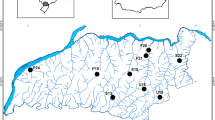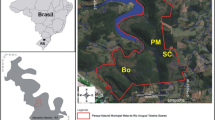Abstract
The damming of rivers and streams alters downstream habitat characteristics and biotic assemblages, and might thus alter stream functioning, although there is not much direct evidence of this impact. In this study we compared breakdown of alder leaves upstream and downstream from 4 small (<1 hm3) dams in 4 Mediterranean mountain streams with no appreciable impact on water temperature and nutrient concentrations. Despite no effect on water characteristics, dams decreased leaf litter breakdown rates. Abundance and biomass of invertebrates and shredders and hyphomycete sporulation rates did not differ between upstream and downstream bags. However, the structure of invertebrate and hyphomycete assemblages did. Especially evident was a drop in limnephilids, which might explain the slower breakdown of leaf litter below dams. These results may help to explain some of the variability found in the literature on the effects of dams on decomposition rates. If dams increase water temperature and nutrient concentrations they may promote faster decomposition, but if dams do not change water characteristics, their impact on detritivore communities may cause slower decomposition rates.



Similar content being viewed by others

References
Allen, S. E., H. M. Grimshaw, J. A. Parkinson & J. A. Quarmby, 1974. Chemical Analysis of Ecological Materials. Blackwell, Oxford, UK.
Anderson, M. J., 2001. Permutation tests for univariate or multivariate analysis of variance and regression. Canadian Journal of Fisheries and Aquatic Sciences 58: 629–636.
Anderson, M. J. & J. Robinson, 2003. Generalised discriminant analysis based on distances. Australian and New Zealand Journal of Statistics 45: 301–318.
Baker, D. W., B. P. Bledsoe, C. M. Albano & N. L. Poff, 2011. Downstream effects of diversion dams on sediment and hydraulic conditions of Rocky Mountain streams. River Research and Applications 27: 388–401.
Benjamini, Y. & Y. Hochberg, 1995. Controlling the false discovery rate: a practical and powerful approach to multiple testing. Journal of the Royal Statistical Society: Series B (Methodological) 57: 289–300.
Bolker, B. M., M. E. Brooks, C. J. Clark, S. W. Geange, J. R. Poulsen, M. H. H. Stevens & J. D. S. Wite, 2009. Generalized linear mixed models: a practical guide for ecology and evolution. Trends in Ecology & Evolution 24: 127–135.
Bunn, S. E. & A. H. Arthington, 2002. Basic principles and ecological consequences of altered flow regimes for aquatic biodiversity. Environmental Management 30: 492–507.
Camargo, J. A., A. Alonso & M. de la Puente, 2005. Eutrophication downstream from small reservoirs in mountain rivers of Central Spain. Water Research 39: 3376–3384.
Casas, J. J., C. Zamora-Muñoz, F. Archila & J. Alba-Tercedor, 2000. The effect of a headwater dam on the use of leaf bags by invertebrate communities. Regulated Rivers-Research and Management 16: 557–591.
Chung, N. & K. Suberkropp, 2009. Effects of aquatic fungi on feeding preferences and bioenergetics of Pycnopsyche gentilis (Trichoptera: Limnephilidae). Hydrobiologia 630: 257–269.
Clarke, K. R., 1993. Non-parametric multivariate analysis of changes in community structure. Australian Journal of Ecology 18: 117–143.
Clarke, K. R. & R. N. Gorley, 2006. PRIMER v6: User Manual/Tutorial. PRIMER-E, Plymouth.
Cummins, K. W., 1973. Trophic relations of aquatic insects. Annual Review of Entomology 18: 183–206.
Dangles, O. & B. Malmqvist, 2004. Species richness-decomposition relationships depend on species dominance. Ecology Letters 7: 395–402.
Dudgeon, D., 2010. Requiem for a river: extinctions, climate change and the last of the Yangtze. Aquatic Conservation: Marine and Freshwater Ecosystems 20: 127–131.
Elosegi, A., J. R. Díez & M. Mutz, 2010. Effects of hydromorphological integrity on biodiversity and functioning of river ecosystems. Hydrobiologia 657: 199–215.
Friedl, G. & A. Wüest, 2002. Disrupting biogeochemical cycles—consequences of damming. Aquatic Sciences 64: 55–65.
Gessner, M. O., E. Chauvet & M. Dobson, 1999. A perspective on leaf litter breakdown in streams. Oikos 85: 377–384.
Giller, P. S. & B. Malmqvist, 1998. The Biology of Streams and Rivers. Oxford University Press, Oxford.
González, J. M. & M. A. S. Graça, 2003. Conversion of leaf litter to secondary production by the shredder caddisfly Sericostoma vittatum. Freshwater Biology 48: 1578–1592.
Hieber, M. & M. O. Gessner, 2002. Contribution of stream detritivores, fungi, and bacteria to leaf breakdown, based on biomass estimates. Ecology 83: 1026–1038.
Kondolf, G. M., 1997. Hungry water: effects of dams and gravel mining on river channels. Environmental Management 21: 533–551.
Leberfinger, K., I. Bohman & J. Herrmann, 2010. Drought impact on stream detritivores: experimental effects on leaf litter breakdown and life cycles. Hydrobiologia 652: 247–254.
Lemmon, P. E., 1956. A spherical densitometer for estimating forest overstory density. Forest Science 2: 314–320.
Marshall, D. W., M. Otto, J. C. Panuska, S. R. Jaeger, D. Sefton & T. R. Baumberger, 2006. Effects of hypolimnetic releases on two impoundments and their receiving streams in Southwest Wisconsin. Lake and Reservoir Management 22: 223–232.
Mendoza-Lera, C., A. Larrañaga, J. Pérez, E. Descals, M. A. Moya, I. Aróstegui & J. Pozo, 2012. Headwater reservoirs weaken terrestrial-aquatic linkage by slowing leaf-litter processing in downstream regulated reaches. River Research and Applications 28: 13–22.
Menéndez, M., E. Descals, T. Riera, & O. Moya, 2012. Effect of small reservoirs on leaf litter decomposition in Mediterranean headwater streams. Hydrobiologia. doi:10.1007/s10750-012-1064-6.
Merrix, F. L., B. R. Lewis & S. J. Ormerod, 2006. The effects of low pH and palliative liming on beech litter decomposition in acid-sensitive streams. Hydrobiologia 571: 373–381.
Muehlbauer, J. D., C. J. LeRoy, J. M. Lovett, K. K. Flaccus, J. K. Vlieg & J. C. Marks, 2009. Short-term responses of decomposers to flow restoration in Fossil Creek, Arizona, USA. Hydrobiologia 618: 35–45.
Munné, A. C., C. Solà & N. Prat, 1998. QBR: Un índice rápido para la evaluación de la calidad de los ecosistemas de ribera. Tecnología del Agua 175: 20–37.
Nakano, S. & M. Murakami, 2001. Reciprocal subsidies: dynamic interdependence between terrestrial and aquatic food webs. Proceedings of the National Academy of Science (USA) 98: 166–170.
Nelson, S. M. & R. A. Roline, 2000. Leaf litter breakdown in a mountain stream impacted by a hypolimnetic release reservoir. Journal of Freshwater Ecology 15: 479–490.
Nilsson, C., C. Reidy, M. Dynesius & C. Revenga, 2005. Fragmentation and flow regulation of the world’s large river systems. Science 308: 405–408.
Pardo, I., M. Álvarez, J. Casas, J. L. Moreno, S. Vivas, N. Bonada, J. Alba-Tercedor, P. Jáimez-Cuéllar, G. Moyà, N. Prat, S. Robles, M. L. Suárez, M. Toro & M. R. Vidal-Abarca, 2002. El hábitat de los ríos mediterráneos. Diseño de un índice de diversidad de hábitat. Limnetica 21: 115–133.
Pascoal, C. & F. Cássio, 2004. Contribution of fungi and bacteria to leaf litter decomposition in a polluted river. Applied and Environmental Microbiology 70: 5266–5273.
Pettit, N., T. Davies, J. Fellman, P. Grierson, D. Warfe & P. Davies, 2012. Leaf litter chemistry, decomposition and assimilation by macroinvertebrates in two tropical streams. Hydrobiologia 680: 63–77.
Poff, N. L., J. D. Olden, D. M. Merritt & D. M. Pepin, 2007. Homogenization of regional river dynamics by dams and global biodiversity implications. Proceedings of the National Academy of Science (USA) 104: 5732–5737.
Pozo, J., J. Casas, M. Menéndez, S. Mollá, I. Arostegui, A. Basaguren, C. Casado, E. Descals, J. García-Avilés, J. M. González, A. Larrañaga, E. López, M. Lusi, O. Moya, J. Pérez, T. Riera, N. Roblas & M. J. Salinas, 2011. Leaf-litter decomposition in headwater streams: a comparison of the process among four climatic regions. Journal of the North American Benthological Society 30: 935–950.
R Development Core Team, 2009. R: A language and environment for statistical computing. R Foundation for Statistical Computing, Vienna, Austria.
Reiss, J., R. A. Bailey, D. M. Perkins, A. Pluchinotta & G. Woodward, 2011. Testing effects of consumer richness, evenness and body size on ecosystem functioning. Journal of Animal Ecology 80: 1145–1154.
Richardson, J. S., Y. Zhang & L. B. Marczak, 2010. Resource subsidies across the land-freshwater interface and responses in recipient communities. River Research and Applications 26: 55–66.
Schlielf, S. & M. Mutz, 2009. Effect of sudden flow reduction on the decomposition of alder leaves (Alnus glutinosa [L.] Gaertn.) in a temperate lowland stream: a mesocosm study. Hydrobiologia 624: 205–217.
Short, R. A. & J. V. Ward, 1980. Leaf litter processing in a regulated Rocky Mountain stream. Canadian Journal of Fisheries and Aquatic Sciences 37: 123–127.
Simon, K. S., M. A. Simon & E. F. Benfield, 2009. Variation in ecosystem function in Appalachian streams along an acidity gradient. Ecological Applications 19: 1147–1160.
Stanford, J. A. & J. Ward, 2001. Revisiting the serial discontinuity concept. Regulated Rivers: Research & Management 17: 303–310.
Tank, J. L., E. J. Rosi-Marshall, N. A. Griffiths, S. A. Entrekin & M. L. Stephen, 2010. A review of allochthonous organic matter dynamics and metabolism. Journal of the North American Benthological Society 29: 118–146.
Ward, J. V. & J. A. Stanford, 1983. The serial discontinuity concept of lotic ecosystems. In Fontaine, T. D. & S. M. Bartell (eds), Dynamics of lotic ecosystems. Ann Arbor Science Publishers, Michigan: 29–42.
Webster, J. R., E. F. Benfield, T. P. Ehrman, M. A. Schaeffer, J. L. Tank, J. J. Hutchens & D. J. D’Angelo, 1999. What happens to allochthonous material that falls into streams? A synthesis of new and published information from Coweeta. Freshwater Biology 41: 687–705.
Wipfli, M. S., J. S. Richardson & R. J. Naiman, 2007. Ecological linkages between headwaters and downstream ecosystems: Transport of organic matter, invertebrates, and wood down headwater channels. Journal of the American Water Resources Association 43: 72–85.
Zuur, A. F., E. N. Ieno, N. Walker, A. A. Saveliev & G. M. Smith, 2009. Mixed effects models and extensions in ecology with R. Springer, Dordrecht.
Acknowledgments
This study was funded by the Spanish Ministry of Science and Innovation project Imparios (CGL2007-66664-C04-03). We are grateful to Fernando Rodríguez, Roberto Velilla, Isaac Navarro and Javier de la Calle for help with field and laboratory work. We thank Arturo Elosegi and anonymous reviewers for helpful comments on the manuscript. We are also grateful to the other participants in the Imparios project in Andalusia, Basque Country and Catalonia for their assistance in improving the study design. The size and volume of dams were obtained from the Inventario de Presas y Embalses compiled by the Spanish Ministry of the Environment and Rural and Marine Affairs.
Author information
Authors and Affiliations
Corresponding author
Additional information
Guest editors: A. Elosegi, M. Mutz & H. Piégay / Form and function: channel form, hydraulic integrity, and river ecosystem functioning
Rights and permissions
About this article
Cite this article
González, J.M., Mollá, S., Roblas, N. et al. Small dams decrease leaf litter breakdown rates in Mediterranean mountain streams. Hydrobiologia 712, 117–128 (2013). https://doi.org/10.1007/s10750-012-1144-7
Received:
Accepted:
Published:
Issue Date:
DOI: https://doi.org/10.1007/s10750-012-1144-7



